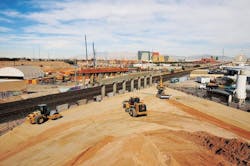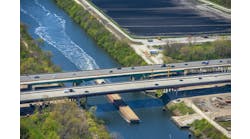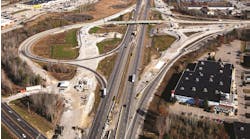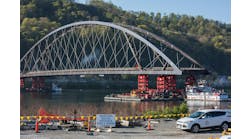Almost everyone is familiar with the often agreed-upon mantra that whatever happens in Vegas should stay there.
Fortunately for the road construction industry and motorists traversing the area, the Nevada DOT (NDOT) is not withholding the juicier details regarding its extensive work in Sin City on Project Neon, the largest and most expensive public works project ever undertaken in the state’s 155-year history. In fact, the department has not been shy about sharing information with the traveling public throughout the project’s construction, taking pride in the public outreach campaign designed to help motorists navigate the project footprint.
“I would say that Project Neon really set the bar as far as how we interact with the public,” Cole Mortensen, P.E., CPM, NDOT Deputy Director, told Roads & Bridges. Project Neon was the agency’s first endeavor to provide a mobile app, which allowed the public to view photos and videos of construction in addition to notifying road users of closures and detour routes.
Project Neon upgraded nearly 4 miles of I-15 between Sahara Avenue and the Spaghetti Bowl Interchange in downtown Las Vegas. The project footprint covers the busiest stretch of highway in Nevada, seeing 300,000 vehicles per day and 25,000 lane changes per hour. “The project itself is on the I-15 just south of where it connects with U.S. 95,” Mortensen said. “It’s a critical corridor for us in that it’s right in the heart of the transportation system in Las Vegas where the two major routes cross.”
The scope and impact of the project combined with effective traffic management strategies on a tight project footprint, the use of major project branding, and early completion by the contractor all helped Project Neon earn the top spot on Roads & Bridges’ Top 10 Roads projects for 2019.
STAYING ON BRAND
Part of the public engagement strategy included major branding for the three Project Neon work phases. The first phase—which began in October 2016— was dubbed “Car-nado,” while “The Big Squeeze” phase for the work along U.S. 95 was sandwiched in the middle of the project timeline, and “The Main Event” rounded out the project schedule with work along I-15. The project consisted of 63 lane-miles of new concrete and asphalt paving, as well as the demolition of 24 bridges along the system and the construction of 29 new structures.
In addition to upgrading pavement and bridges, Project Neon expanded the high-occupancy vehicle (HOV) lane network in the Las Vegas Valley. The region initially gained 10 miles of HOV lanes through the U.S. 95 Northwest Corridor Improvements project. NDOT had a master plan in place for the HOV system to eventually include high-occupancy lanes along I-15. The connection of Project Neon to the HOV system provided the final link for implementing an expanded HOV network with over 20 miles of continuous lanes along U.S. 95 and I-15. The new HOV lanes will allow motorists in the region to exit at the dedicated Neon Gateway interchange, which empties onto Western Avenue for easier downtown access.
“The Neon Gateway is a first-of-its-kind direct-access interchange for us,” Mortensen explained. “Basically it allows traffic to interact with the HOV system directly from local streets, rather than having to weave across the general-purpose lanes to get in the HOV system. So it’s really a way of creating a far more safe way of interacting with the local roadways from the HOV system.”
Project Neon also featured a new freeway on-ramp at Pinto Lane on I-15 southbound, plus an entirely reconfigured full diamond interchange at Charleston Boulevard with a new I-15 northbound off-ramp that enables westbound travel and direct entry to Grand Central Parkway and Alta Drive/Bonneville Avenue.
Another component of Project Neon included the revamping of Martin Luther King (MLK) Boulevard for improved north-south operations adjacent to I-15. Additionally, the southbound U.S. 95 off-ramp to MLK was reconfigured for added lane capacity. Similarly, the I-15 southbound off-ramp to Sahara Avenue received more space for westbound travel, and the U.S. 95 southbound off-ramp to Rancho Drive was also rebuilt for more capacity, thereby reducing freeway backups along the corridor.
For NDOT, one of the biggest challenges was maintaining the flow of traffic for 300,000 vehicles a day on a tight project footprint. “We heavily incentivized the contractor at various milestones throughout the project to get completed to minimize the amount of impact it had to the traveling public,” Mortensen said. In particular, orchestrating the demolition and construction of bridges along the corridor while keeping traffic moving proved to be an arduous task. “I think that anytime you have a project that’s right in the middle of an interstate system like that, access for construction is critical—especially when you’re moving over 1 million cu yd worth of fill.”
In order to enhance safety and highway operations, the Project Neon team implemented ramp braiding along the project in order to avoid the vehicle interaction and competition that occurs when vehicles entering the freeway from an on-ramp try to merge with traffic attempting to exit the highway onto another ramp. “We’re braiding the ramps so the off-ramp would either go over or under the on-ramp traffic,” Mortensen said. “The other thing that’s really helpful for us is the HOV lanes and actually having that direct connect ramp from U.S. 95 to I-15 because that keeps all the traffic and the HOV lanes from having to weave across general-purpose lanes to utilize that ramp movement.”
NDOT is also implementing a new active traffic management (ATM) system—the first of its kind in Nevada—along Project Neon in order to enhance efficiency and reduce travel delays. Forty-two ATM signs will be installed along the corridor in order to help the department actively manage speed and provide information to motorists along a stretch of highway that is expected to double in traffic count over the next two decades.
The team adopted a design-build approach that delivered the project nearly a year earlier than originally anticipated. In addition, contractor Kiewit Construction also beat its own project timeline, partially due to incentives to finish early. “Not only were they done a year faster than we thought anybody could get it done, but they beat their [own] schedule by three months,” Mortensen said.
Work on Project Neon made it to substantial completion by May 15, 2019, with an official ribbon-cutting ceremony that took place in August of this year.



